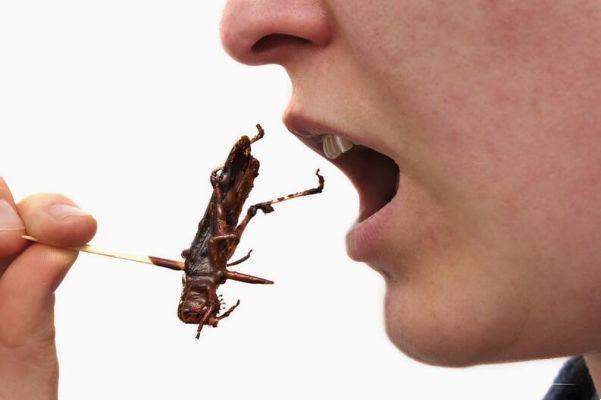
Technically it is defined entomophagy the practice of feeding on insects.
It has very ancient origins, protohuman, when primates found insects an excellent supplementary source of their purely fruit-vegetarian diet. The Gospels depict the figure of John the Baptist in the desert feeding on grasshoppers and wild honey, just to give an example.
But why do insects continue to be eaten after millennia? And which of them are the most eaten?
They represent perhaps one rIs it risen for the future or is it a food destined to disappear like all obsolete traditions?
Eating insects: some data
Let's start with some data: the nations where insects are not eaten are the minority, all concentrated in the so-called “developed world”.
Turning for Asia, Africa, Asia, America Latina e Oceania, we will find that eating insects still does part of traditional diets, and about two thousand different species are regularly eaten every day.
It is no coincidence that FAO has begun to study the phenomenon with an interest in its potential to feed the world's poorest population.
What insects do you eat?
Spiders, larvae, crickets, grasshoppers, cicadas, ants, termites, caterpillars and worms, scorpions, snails and millipedes. What has changed from cave times to today? Just wander around a South American, Chinese or Thai market to find out.
At the dawn of the human era, even before the first hominids developed the use of tools, eating insects was an easy, convenient and quick option, as confirmed by paleontological analyzes.
Over the millennia, humans have never completely abandoned the practice of eating insects, but rather evolved it, so much so that today we can find cricket skewers, grasshoppers, ant lollipops, termite chocolate, cockroaches in sauce.
Traditional use, linked above all to populations who live in contact with nature, remains the main. We can still see the Amazonian populations struggling with the tarantulas to be roasted, or the aborigines taste the ants near a hollow log; desert populations and those of tropical and subtropical zones are the more Consumers.
In the Western world, the idea of eating insects is struggling to take root, despite the fact that restaurants snack here and there and, as happened at the recent EXPO in Milan, the theme was dealt with and the diet including insects has been proposed as a solution for many problems related to ipollution from farms. Insects are proposed as novel food by many institutions: easy to breed, they have a high nutritional potential.
In fact, what do we find in insects at a nutritional level? Let's consider some examples.
Eating the larvae
The larva is the embryonic phase of the insect's life, through which it gradually develops from the egg to the adult individual.
We find larvae of all kinds, one of the most famous is that present in the agave that Mexicans they love to put in the liqueur called mescal.
On average, dried larvae contain a very broad spectrum of essential amino acids, a dozen fatty acids and a good dose of trace elements which varies according to the plant they feed on. The protein level is incredibly high, oscillating around 40%.
Eat the ants
Just some ant species are edible, as many of them produce formic acid, toxic for human organism.
Edible ants are considered a cure-all to keep vision health, both in the Chinese medicinethat in that Ayurvedic than in the traditional one Amazon.
The dispute over their taste is curious: from the aborigines to the Colombian peoples it seems that the ants taste of pistachio or lemon peel.
Eating cicadas
Soon said: low in fat and lots of proteins, with a good range of vitamins.
Cicadas spend almost all of their life sucking the roots of very nutritious plants; this specific feeding gives them a flavor somewhere between crabmeat and asparagus, it seems.
They are generally consumed with chocolate, roasted in herbs, or placed in a juice extractor along with fruit and vegetables. After all, cicadas are part of the same Phylum as lobsters and shrimps.
Crickets and grasshoppers
Speaking of shrimp… here are two insects that can easily replace their taste; it is well known that the great shrimp and scampi farms have destroyed thousands of kilometers of coastline around the world, clearing much of the mangrove forests.
How to solve the problem? Spiced crickets and grasshopper soup. They look like witch-like ingredients but once you try them you will be convinced.
It is very nutritious foods: again we have a food very rich in proteins (similar to those of chicken) and low in fat and carbohydrates.
Perspectives: pros and cons of eating insects
As mentioned, FAO is seriously considering this the pros of the insect diet in the perspective of a population that is supposed to reach nine billion people by 2050.
As mentioned insects are very easy to breed, and their breeding does not involve, apparently, such high pollution levels such as those caused by mammal, bird or fish farms. But it is not just a "greener" production, it is also an apparent question of better food quality and ease of storage. Last but not least, their production is also much cheaper.
What are the cons? Difficult to say precisely because this food practice has never been extended to a very great level and therefore it cannot be easily foreseen all environmental impactsi of a large-scale breeding. It certainly won't be easy educating the instincts and promoting such a diet seen a rather common disgust towards this kind of animals and, on the other hand, the increasingly widespread vegan diet.
Farmageddon: the complaint against intensive farming


























